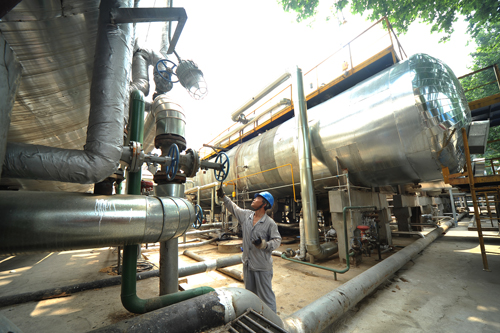Gilitek(Suzhou)Precision Instrument Co. Ltd
Contacts :
Mr. Wang +86-13700518541
Ms. Jiang +86-18666211019
Address : sales@gilitek.cn
website:www.gilitek.com
The increasing number of people and the density of the population have brought pressure to the water supply in many places. According to the United Nations predicts that by the middle of this century, there are 20-70 million people will face a lack of water resources. In response to this situation, the water industry will become more and more dependent on the desalination of seawater and brackish water.
Desalination technology is divided into membrane method and thermal method. The main disadvantage of desalination technology is high cost. In SWRO technology, power consumption accounts for 30% of the total cost of treatment, so reducing energy consumption is the key to reducing the cost of desalination. Some new membrane materials can reduce energy consumption and bring to a good desalination effect.

1 nano composite film
Nano composite film material (TFN) membrane is the Linde type a zeolite nanoparticles were added into the membrane separation layer to improve permeability and keep the desalination rate. Lind A zeolite nanoparticles increase the water permeability, can reduce the inlet pressure while maintaining the same rate of water production, thereby reducing energy consumption. Compared to the typical pure polyamide composite membrane (TFC), coating equipment due to the presence of nano pore, these TFN membranes more smooth, more hydrophilicity, surface with more negative charge, improve the permeability of the membrane and its essence is in the membrane matrix to create molecular hydrophilic channel to let the water through a preferred, and the negative charge of the nano pore wall more coating equipment enhanced ion exclusion, in order to maintain the desalination rate. According to reports, TFN membrane permeation flux up to 52m3, D-1, NaCl desalination rate as low as 99.7%.
At the laboratory scale, the researchers evaluated two different types of TFN membranes. Compared to non modified polysulfone support layer, adding nanoparticles of polysulfone support layer with smaller water contact angle and higher ultimate tensile strength. But the results of laboratory studies with commercial TFC films are not directly comparable.
The comparison of TFN and TFC films showed that the permeability of TFN membrane was 1.4 times higher than that of TFC film. Although the TFN film showed a higher water permeability, and maintained a similar desalination rate, but its boron and low molecular weight of the removal rate of the lower molecular weight than the TFC film is low. At present, the new generation of TFN film has improved the removal rate of boron, but its permeability is equivalent to that of TFC film. It is not clear whether the nanoparticle concentration in the active layer of the TFN membrane can increase the permeability.
In a recent study, researchers compared TFN film NanoH2O Qfx400R, Qfx400ES and Dow TFC membrane SW30XLE, SW30ULE for Pacific seawater desalination and corresponding influent TDS for 34000mg, l 1. In 11.9-15.3L, m-2, membrane flux was H-1, the system recovery rate is 40-55%, TFN is 2.24-2.55kWh, the energy consumption of membrane m-3. In the same flux and recovery rate, energy consumption of TFC film is 2.28-2.61kWh, m-3. Therefore, the use of TFN film to save energy less than 6%. The boron removal rate was low compared to the TFC film using the TFN film. However in seawater desalination with saline through the secondary RO system pH is around 10.3, which can make the water very low content of boron (<0.5mg, L-1) in the system. When choosing between the RO TFN film and the RO TFC film, you also need to consider the cost of the entire life cycle. When the cost of TFN membrane component is higher, the cost of capital will be higher. However, due to the reduction in the cost of energy consumption throughout the operating period, the whole life cycle cost of water plant may be lower.
2 water channel protein film
Water channel proteins are proteins that control water through biological membranes. The movement of water molecules in the water channel protein is caused by the selective, rapid diffusion, and the osmotic gradient. Water channel protein -1 (AQP1) in the cell and the cell has a selective vestibular, will allow water molecules to be quickly passed, and the separation of protein and blocking ions through electrostatic tuning mechanism.
The permeability of water channel protein film is 100 times higher than that of commercial RO membrane. The high permeability and selective membrane formed by the incorporation of functional water channel protein -Z into the novel three block copolymers have been shown to have a significantly higher permeability than the existing RO membranes. The study of the water channel protein attached to commercial membranes has been advancing. In pH=2, the researchers attached water channel proteins to NF270 and NTR7450 commercial membranes by vesicle fusion. The results show that the support double lipid layer formed dense water osmosis nanofiltration (NF) membrane can be run in with the RO membrane equal driving pressures. The NF film is selected as the support layer due to its high permeability and low surface roughness, which can achieve the minimum deformation of the lipid bilayer.
The water channel protein film shows the potential of desalination, the driving mechanism is the osmotic pressure gradient (salt concentration), rather than the mechanical application of pressure gradient like RO. When the membrane water channel protein coverage rate of 75%, the prediction of hydraulic permeability will increase by an order of magnitude. Due to the lack of pressure, energy consumption and RO film will be significantly reduced. Due to the difficulty in obtaining large amounts of protein and producing large areas of membrane materials, the water channel protein film is not widely used in commercial.
